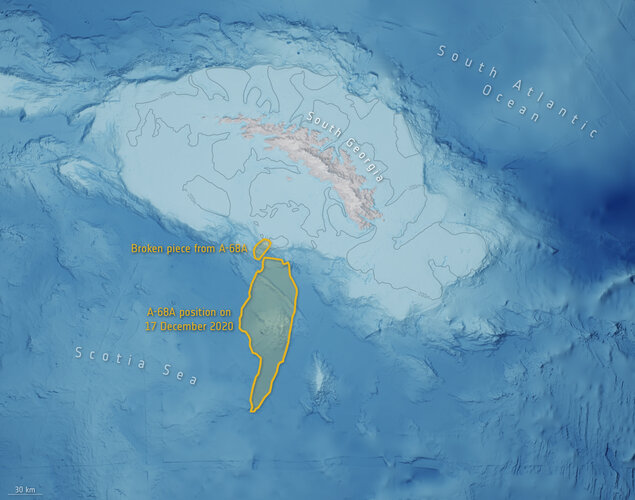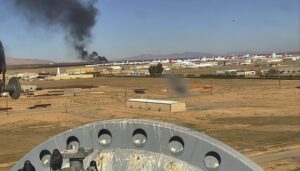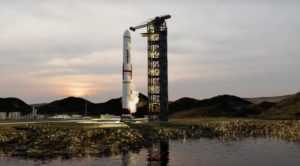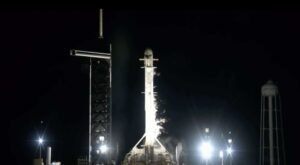Mega iceberg released 152 billion tonnes of freshwater
Thursday, 20 January 2022 08:00
In July 2017, a giant iceberg, named A-68, snapped off Antarctica’s Larsen-C ice shelf and began an epic journey across the Southern Ocean. Three and a half years later, the main part of iceberg, A-68A, drifted worryingly close to South Georgia. Concerns were that the berg would run aground in the shallow waters offshore. This would not only cause damage to the seafloor ecosystem but also make it difficult for island wildlife, such as penguins, to make their way to the sea to feed. Using measurements from satellites, scientists have charted how A-68A shrunk towards the end
IMDO, MDA complete flight tests for the Arrow Weapon System and Arrow 3 Interceptor
Thursday, 20 January 2022 07:30 the Israel Missile Defense Organization (IMDO) of the Directorate of the Defense Research and Development (DDR and D) at Israel's Ministry of Defense, together with the U.S. Missile Defense Agency (MDA) and Israeli Defense Forces, conducted a successful flight test of the Arrow Weapon System (AWS) and the Arrow 3 interceptor at a test site in central Israel.
AWS radars detected the target
the Israel Missile Defense Organization (IMDO) of the Directorate of the Defense Research and Development (DDR and D) at Israel's Ministry of Defense, together with the U.S. Missile Defense Agency (MDA) and Israeli Defense Forces, conducted a successful flight test of the Arrow Weapon System (AWS) and the Arrow 3 interceptor at a test site in central Israel.
AWS radars detected the target Grounded: First Flight Delay Due to Inclement Weather on Another World
Thursday, 20 January 2022 05:37 The atmosphere of Mars is much less dense than Earth's; however, the Mars climate shares many similarities to Earth: seasons, changing winds, ice clouds, and dust storms, among others. Predicting weather events, as is true for Earth, is always an uncertain endeavor. In preparing for Flight 19, we found out that unexpected Mars weather can result in a familiar and unfortunate scenario here on Ear
The atmosphere of Mars is much less dense than Earth's; however, the Mars climate shares many similarities to Earth: seasons, changing winds, ice clouds, and dust storms, among others. Predicting weather events, as is true for Earth, is always an uncertain endeavor. In preparing for Flight 19, we found out that unexpected Mars weather can result in a familiar and unfortunate scenario here on Ear Russian cosmonauts conduct EVA to complete Nauka Lab Module integration to ISS
Thursday, 20 January 2022 05:37 Russia launched the multipurpose laboratory module "Nauka" from the Baikonur cosmodrome on 21 July and it docked at the ISS on 29 July.
Watch a live broadcast from the International Space Station (ISS) as Roscosmos astronauts Anton Shkaplerov and Pyotr Dubrov are performing a spacewalk to integrate the Nauka multipurpose laboratory module into the Russian segment of the ISS.
The modu
Russia launched the multipurpose laboratory module "Nauka" from the Baikonur cosmodrome on 21 July and it docked at the ISS on 29 July.
Watch a live broadcast from the International Space Station (ISS) as Roscosmos astronauts Anton Shkaplerov and Pyotr Dubrov are performing a spacewalk to integrate the Nauka multipurpose laboratory module into the Russian segment of the ISS.
The modu Cosmonauts complete first spacewalk of 2022 to prepare Russian ISS segment
Thursday, 20 January 2022 05:37 Two Russian cosmonauts completed the first spacewalk of 2022 outside the International Space Station to perform tasks that will allow spacecraft to dock with a new Russian segment.
Anton Shkaplerov and Pyotr Dubrov, of the Russian space agency Roscosmos, spent seven hours, 11 minutes outside the space station after exiting just after 7 a.m. EST.
The pair installed handrails, ante
Two Russian cosmonauts completed the first spacewalk of 2022 outside the International Space Station to perform tasks that will allow spacecraft to dock with a new Russian segment.
Anton Shkaplerov and Pyotr Dubrov, of the Russian space agency Roscosmos, spent seven hours, 11 minutes outside the space station after exiting just after 7 a.m. EST.
The pair installed handrails, ante Sol 3361: Keeping the Dog Leashed
Thursday, 20 January 2022 05:37 Our initial plan was to conduct a MAHLI "dog's eye" imaging sequence on the beautiful Panari outcrop that we are parked before.
During a dog's eye sequence, the rover's arm walks the MAHLI camera along a feature near ground level, just how your martian canine (obviously named "Rover") would see it. But, we had to move that to tomorrow's plan due to a couple issues that need resolving first
Our initial plan was to conduct a MAHLI "dog's eye" imaging sequence on the beautiful Panari outcrop that we are parked before.
During a dog's eye sequence, the rover's arm walks the MAHLI camera along a feature near ground level, just how your martian canine (obviously named "Rover") would see it. But, we had to move that to tomorrow's plan due to a couple issues that need resolving first Hubble Finds a Black Hole Igniting Star Formation in a Dwarf Galaxy
Thursday, 20 January 2022 05:37 Often portrayed as destructive monsters that hold light captive, black holes take on a less villainous role in the latest research from NASA's Hubble Space Telescope. A black hole at the heart of the dwarf galaxy Henize 2-10 is creating stars rather than gobbling them up. The black hole is apparently contributing to the firestorm of new star formation taking place in the galaxy. The dwarf galaxy
Often portrayed as destructive monsters that hold light captive, black holes take on a less villainous role in the latest research from NASA's Hubble Space Telescope. A black hole at the heart of the dwarf galaxy Henize 2-10 is creating stars rather than gobbling them up. The black hole is apparently contributing to the firestorm of new star formation taking place in the galaxy. The dwarf galaxy SwRI scientist uncovers evidence for an internal ocean in small Saturn moon
Thursday, 20 January 2022 05:37 A Southwest Research Institute scientist set out to prove that the tiny, innermost moon of Saturn was a frozen inert satellite and instead discovered compelling evidence that Mimas has a liquid internal ocean. In the waning days of NASA's Cassini mission, the spacecraft identified a curious libration, or oscillation, in the moon's rotation, which often points to a geologically active body able t
A Southwest Research Institute scientist set out to prove that the tiny, innermost moon of Saturn was a frozen inert satellite and instead discovered compelling evidence that Mimas has a liquid internal ocean. In the waning days of NASA's Cassini mission, the spacecraft identified a curious libration, or oscillation, in the moon's rotation, which often points to a geologically active body able t NASA's James Webb telescope completes mirror alignment, heads for orbit
Thursday, 20 January 2022 05:37 NASA's James Webb telescope completed alignment all 18 of its primary mirror segments and the secondary mirror on Wednesday, the agency reported.
NASA Administrator Bill Nelson shared the news, tipping his hat to the crew on Twitter.
"Congratulations to the teams that have been working tirelessly since launch to get to this point. Soon, Webb will arrive at its new home, L2," wrot
NASA's James Webb telescope completed alignment all 18 of its primary mirror segments and the secondary mirror on Wednesday, the agency reported.
NASA Administrator Bill Nelson shared the news, tipping his hat to the crew on Twitter.
"Congratulations to the teams that have been working tirelessly since launch to get to this point. Soon, Webb will arrive at its new home, L2," wrot ASU astronomer finds star fuel surrounding galaxies
Thursday, 20 January 2022 05:37 Most galaxies, including our own, grow by accumulating new material and turning them into stars - that much is known. What has been unknown is where that new material comes from and how it flows into galaxies to create stars.
In a recently published study, Arizona State University astronomer Sanchayeeta Borthakur has identified the faint fuel reservoirs that surround galaxies, and how this
Most galaxies, including our own, grow by accumulating new material and turning them into stars - that much is known. What has been unknown is where that new material comes from and how it flows into galaxies to create stars.
In a recently published study, Arizona State University astronomer Sanchayeeta Borthakur has identified the faint fuel reservoirs that surround galaxies, and how this Capturing all that glitters in galaxies with NASA's Webb
Thursday, 20 January 2022 05:37 Spirals are some of the most captivating shapes in the universe. They appear in intricate seashells, carefully constructed spider webs, and even in the curls of ocean waves. Spirals on cosmic scales - as seen in galaxies - are even more arresting, not only for their beauty, but also for the overwhelming amount of information they contain. How do stars and star clusters form? Until recently, a co
Spirals are some of the most captivating shapes in the universe. They appear in intricate seashells, carefully constructed spider webs, and even in the curls of ocean waves. Spirals on cosmic scales - as seen in galaxies - are even more arresting, not only for their beauty, but also for the overwhelming amount of information they contain. How do stars and star clusters form? Until recently, a co China's rocket technology hits the ski slopes
Thursday, 20 January 2022 05:37 Who would ever have thought that technology used on China's largest carrier rocket would be used to improve the safety of skiers?
Chinese scientists have developed a strong ski helmet with space technology originally used on the Long March-5 rocket, the country's heaviest launch vehicle and the carrier of Mars probe Tianwen-1.
The helmet, designed by a team from the Dalian University
Who would ever have thought that technology used on China's largest carrier rocket would be used to improve the safety of skiers?
Chinese scientists have developed a strong ski helmet with space technology originally used on the Long March-5 rocket, the country's heaviest launch vehicle and the carrier of Mars probe Tianwen-1.
The helmet, designed by a team from the Dalian University ABL Space Systems rocket stage destroyed in test accident
Wednesday, 19 January 2022 23:47
ABL Space Systems said the second stage of the small launch vehicle they are developing was destroyed in an accident during testing Jan. 19.
SpaceX wins $102 million Air Force contract to demonstrate technologies for point-to-point space transportation
Wednesday, 19 January 2022 22:42
The U.S. Air Force awarded SpaceX a $102 million five-year contract to demonstrate technologies and capabilities to transport military cargo and humanitarian aid around the world on a heavy rocket.
Pakistan is next to halt Starlink preorders
Wednesday, 19 January 2022 20:59
Pakistan has followed India in ordering SpaceX to stop taking preorders for Starlink broadband services within its borders without a license.

